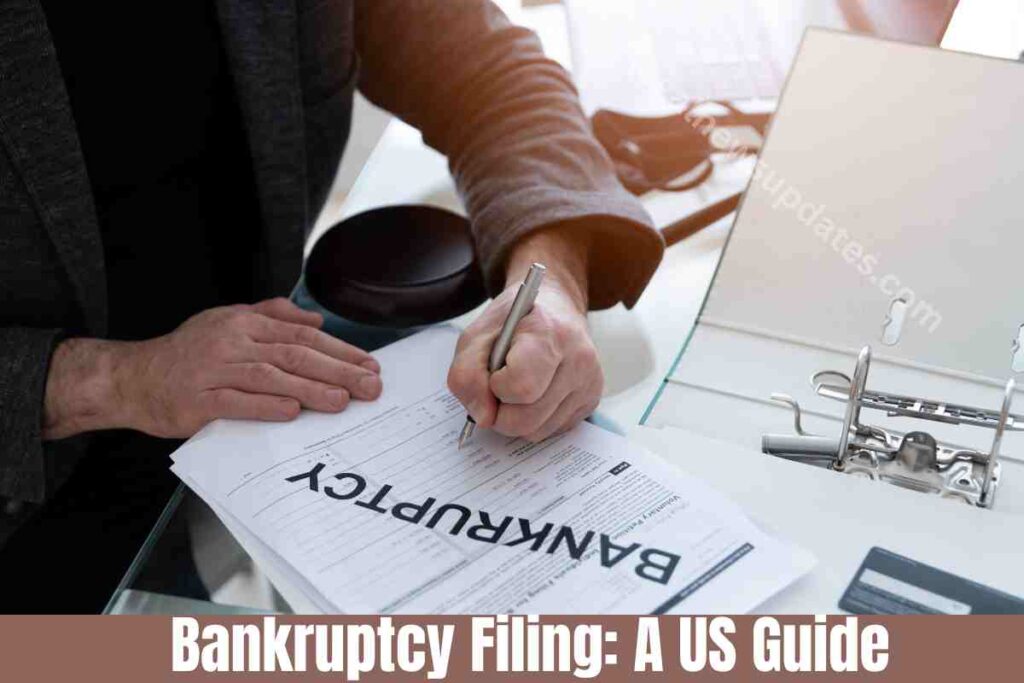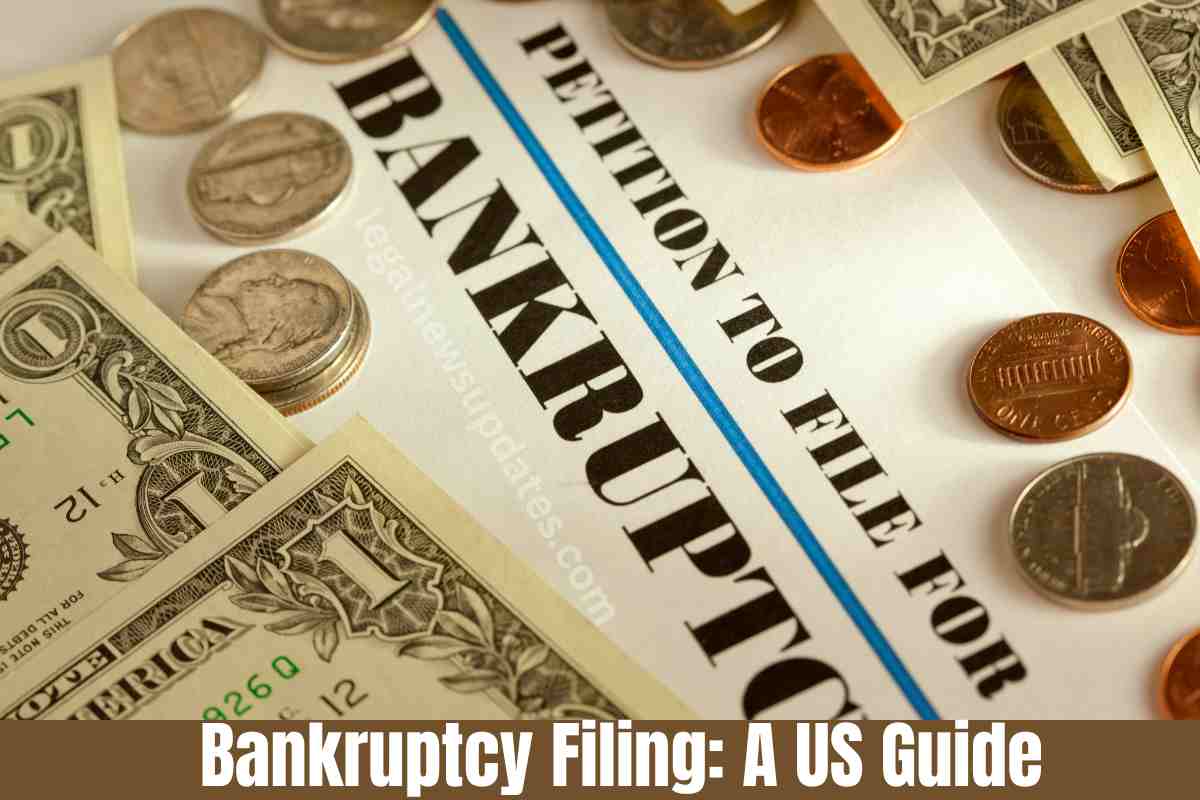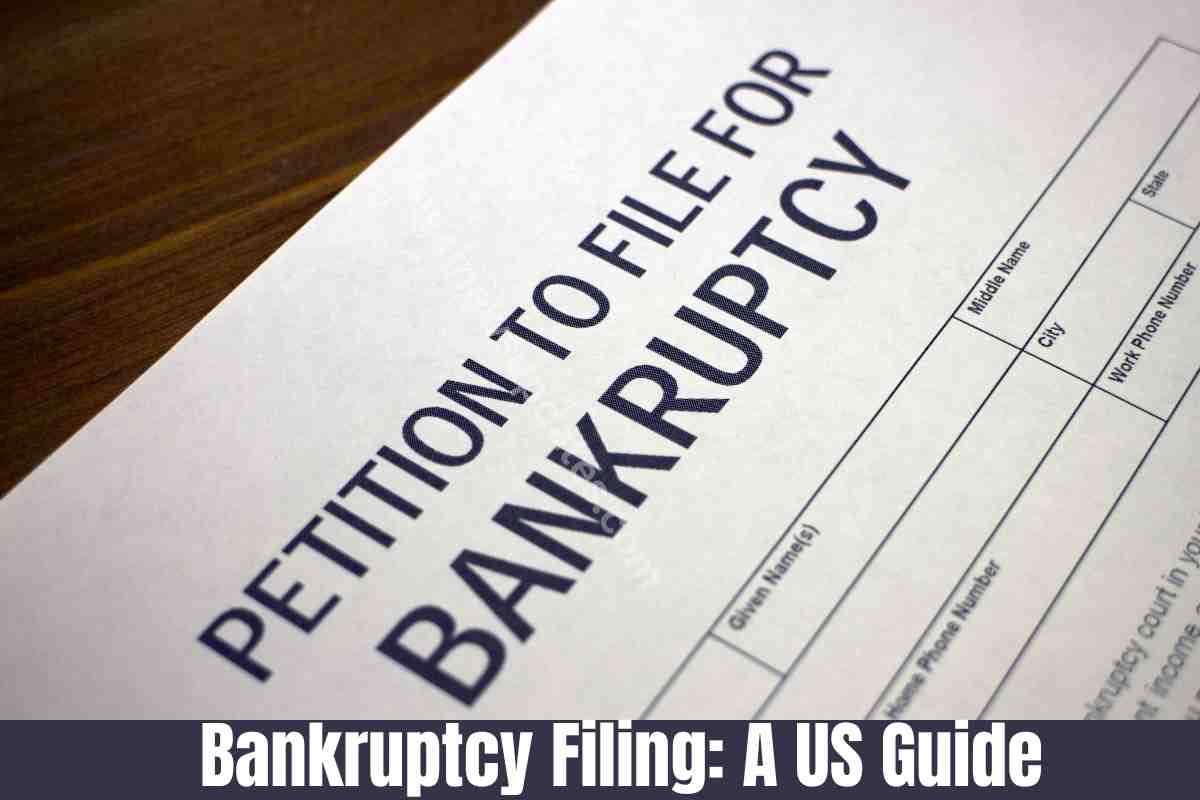Bankruptcy Filing: A US Guide

Introduction
Bankruptcy Filing: A US Guide:-Bankruptcy is a legal process in the United States designed to help individuals and businesses eliminate their debts or repay them under the protection of the bankruptcy court. Bankruptcy laws aim to give people struggling with debt a fresh start while providing a fair way to repay creditors to the extent possible. Understanding the intricacies of bankruptcy filing is crucial, as it can significantly impact one’s financial and personal life.
This comprehensive guide aims to walk you through the bankruptcy process in the USA, helping you understand the different types of bankruptcy, eligibility criteria, preparation steps, and much more. Whether you’re considering filing for bankruptcy yourself or seeking to understand the process for someone else, this guide will provide valuable insights into making informed decisions during a challenging financial period.
In the following sections, we’ll delve into the basics of bankruptcy, explore the different chapters under which you can file, discuss the emotional and financial implications, and guide you through each step of the filing process. We aim to demystify bankruptcy and equip you with the knowledge to navigate this complex journey.
Understanding Bankruptcy
Definition and Basics of Bankruptcy
Bankruptcy is a legal proceeding involving a person or business that cannot repay their outstanding debts. The bankruptcy process begins with a petition filed by the debtor, which is most common, or on behalf of creditors, which is less common. The debtor’s assets are measured and evaluated, and the assets may be used to repay a portion of outstanding debt.
Types of Bankruptcy
In the United States, there are several types of bankruptcy filings, but there are three main chapters under which individuals and businesses can file:
Chapter 7 (Liquidation Bankruptcy): This is individuals’ most common form of bankruptcy. It involves liquidating non-exempt assets to pay off as much debt as possible. The remaining debts are then discharged, meaning the debtor is no longer legally required to pay them.
Chapter 11 (Reorganization Bankruptcy): Often used by businesses, this chapter allows for debt reorganization under the bankruptcy laws of the United States. It provides a plan to keep the company alive and pay creditors over time. Individuals, especially those with substantial debts and assets, may also file under this chapter.
Chapter 13 (Wage Earner’s Plan): This chapter allows individuals with a regular income to develop a plan to repay all or part of their debts. Debtors propose a repayment plan to pay creditors over three to five years.
Differences and Which Type Might Be Right for You
Choosing the correct type of bankruptcy filing depends on your specific financial situation, the types of debts you have, and what you aim to achieve through the filing process. Here are some considerations:
Ch 7 is suitable for individuals without significant assets and seeking a relatively quick way to discharge debts.
Chapter 11 is complex and costly but may be the right choice for businesses that wish to continue operating while repaying debts or for individuals whose debt levels are too high for Chapter 13.
Chapter 13 aims at individuals with a regular income who wish to keep their property while reorganizing their debts.
Understanding the nuances of each bankruptcy type is essential to making an informed decision that aligns with your financial recovery goals.
The Emotional and Financial Impact of Filing for Bankruptcy
Emotional Considerations and Mental Health
Filing for bankruptcy is not just a financial decision; it’s a personal one that comes with significant emotional considerations. Many individuals experience feelings of shame, failure, or embarrassment. Acknowledging these feelings and understanding that bankruptcy is a legal tool designed to provide relief and a fresh start is essential. Seeking support from a mental health professional or support groups can be beneficial.
Financial Implications in the Short and Long Term
Short-term implications include the immediate relief of being protected from debt collection actions, such as wage garnishments, foreclosures, and repossessions. However, the impact on your credit score is significant, as bankruptcy can stay on your credit report for up to 10 years, depending on the chapter filed.
Long-term financial implications involve the rebuilding process. Access to credit will be more challenging, and interest rates will be higher. However, it’s an opportunity to rebuild your financial foundation. Strategies include budgeting, building an emergency fund, and slowly re-establishing credit through secured credit cards or loans.
Eligibility Requirements for Bankruptcy
Bankruptcy is only available to some, and understanding the eligibility requirements is crucial before proceeding.
General Eligibility Criteria
Residency: You must reside, have a domicile, a place of business, or property in the U.S.
Credit Counseling: Completing credit counseling within 180 days before filing is required.
Previous Bankruptcy: If you have previously filed for bankruptcy, certain time restrictions may apply before you can file again.
Specific Requirements for Chapters 7, 11, and 13
Chapter 7: Eligibility is primarily determined through the means test, which compares your income to the median income for a household of your size in your state. If your income is too high, you may not qualify.
Chapter 11: There are no specific income requirements, but the process is complex and typically more suited to businesses or individuals with substantial assets and debts.
Chapter 13: You must have a regular income, and your unsecured debts must be below $419,275, while secured debts must be less than $1,257,850 (these figures are subject to adjustments for inflation).
Preparing to File for Bankruptcy Filing: A US Guide
The preparation phase is crucial for a successful bankruptcy filing.
Gathering Necessary Documents
You must compile a comprehensive list of your debts, assets, income, and expenses. Documents required typically include tax returns, pay stubs, loan documents, and a list of creditors.
Credit Counseling Requirements
Before filing, you must complete a credit counseling course from an approved agency. This requirement aims to ensure you understand all of your options before deciding to file for bankruptcy.
Understanding the Costs Involved
Filing for bankruptcy involves various costs, including filing, attorney, and credit counseling fees. Given the complexity and length of these cases, chapter 7 typically has lower overall costs than Chapter 13 or Chapter 11.
This section covers the emotional and financial considerations of filing for bankruptcy, the eligibility criteria for different chapters, and the initial steps in preparing to file. It’s essential to approach this process clearly and understand its immediate and long-term implications. Next, we would delve into each chapter’s step-by-step bankruptcy filing process, providing detailed guidance on navigating these legal proceedings.
The Step-by-Step Bankruptcy Filing Process
Navigating the bankruptcy process requires careful planning and understanding of legal requirements. We break down the steps for each of the most common types of bankruptcy filings.
Filing Chapter 7 Bankruptcy: The Liquidation Process
Credit Counseling: Complete a credit counseling course from an approved agency within 180 days before filing.
Means Test: Determine eligibility for Chapter 7 bankruptcy through the means test, which assesses your income relative to the median in your state.
Gather Documentation: Compile necessary financial documents, including assets, debts, income, expenses, and a list of creditors.
Hire a Bankruptcy Attorney: While it’s possible to file independently, hiring an experienced attorney can help navigate the complexities of bankruptcy law.
File the Petition: Filing the bankruptcy petition officially starts your case. You’ll need to file several forms detailing your financial situation.
Automatic Stay: An automatic stay goes into effect upon filing, halting most collection actions against you.
Trustee Appointment: The court appoints a bankruptcy trustee to oversee your case, evaluate your assets, and manage creditor payments.
341 Meeting (Meeting of Creditors): You must attend a meeting where creditors can ask questions about your finances and bankruptcy filing.
Liquidation of Non-Exempt Assets: If you have non-exempt assets, the trustee may sell them to pay back creditors.
Debt Discharge: Most of your remaining debts will be discharged upon completion of the process.
Filing Chapter 11 Bankruptcy: The Reorganization Process
Credit Counseling: As with Chapter 7, complete a credit counseling course.
Prepare and File Petition: Chapter 11 requires extensive documentation, including detailed lists of assets, liabilities, and a statement of financial affairs.
Automatic Stay: Filing initiates an automatic stay, providing temporary relief from creditors.
Operating Reports: Debtors must file regular operating reports showing income and expenses.
Reorganization Plan: The debtor proposes a reorganization plan to keep the business operating while paying creditors over time.
Creditor Committees: In some cases, creditors’ committees are formed to oversee the reorganization plan.
Plan Confirmation: The court must approve the reorganization plan, which requires meeting specific criteria and often creditor support.
Implementation: Once confirmed, the debtor must implement the plan, which may involve restructuring operations and finances.
Discharge: Debts may be discharged or restructured according to the confirmed plan.
Filing Chapter 13 Bankruptcy: The Wage Earner’s Plan
Credit Counseling: Complete the required credit counseling course.
File the Petition and Plan: Along with filing your petition, you’ll submit a proposed repayment plan detailing how to pay off debts over three to five years.
Automatic Stay: The filing immediately triggers an automatic stay.
Trustee Appointment: The court appoints a trustee to oversee the case and collect payments to distribute to creditors.
341 Meeting: Attend the creditors’ meeting, where the trustee and creditors can ask questions.
Plan Confirmation: The court must confirm your repayment plan, ensuring it meets legal standards and is feasible.
Make Payments: Begin making payments according to the confirmed plan.
Discharge: Upon completion of the repayment plan, most remaining debts are discharged.
Each type of bankruptcy has unique steps and requirements, reflecting the differences in their intended outcomes and the individuals or entities they serve. Understanding these steps is crucial for a smooth bankruptcy process and achieving financial relief.
Life During Bankruptcy
What to Expect After Filing
Once your bankruptcy petition is filed, you’ll enter an adjustment period. The automatic stay immediately takes effect, offering temporary relief from debt collection actions, but this is just the beginning. Depending on the type of bankruptcy filed, your experience during this period will vary.
For Chapter 7 filers, the process is relatively quick, usually lasting 4-6 months. You should surrender non-exempt assets (if any) for liquidation. The primary focus during this time is to comply with bankruptcy procedures and requirements, including attending the creditors’ meeting.
For Chapter 13 and Chapter 11 filers, the process is longer, involving adherence to a repayment plan over three to five years (Chapter 13) or executing a reorganization plan (Chapter 11). This period requires consistent communication with the trustee, timely payments, and strict budgets.
Managing Your Finances During Bankruptcy Filing: A US Guide
Bankruptcy can significantly alter how you manage your finances. Creating and living by a budget has become more critical than ever. You’ll need to:
Track your spending closely to ensure it aligns with the requirements of your bankruptcy plan.
Prioritize saving, even if it’s a small amount, to build an emergency fund and avoid future financial distress.
Reevaluate your financial goals and plan for achieving them post-bankruptcy.
Restrictions and Obligations
Bankruptcy comes with its set of restrictions and obligations designed to protect both the debtor and creditors:
Incurring New Debt: Generally, you’re restricted from incurring substantial new debt during bankruptcy without the court’s permission.
Asset Disposal: Selling or giving away assets during bankruptcy is restricted and typically requires approval.
Financial Reporting: Especially relevant in Chapter 13 and Chapter 11 cases, you may be required to submit regular financial reports to the bankruptcy trustee.
The Consequences and Outcomes of Bankruptcy Filing: A US Guide
Dischargeable vs. Non-dischargeable Debts
Understanding which debts can be discharged (eliminated) and which cannot is critical. Most unsecured debts, like credit card debt and medical bills, are dischargeable. However, debts like student loans, child support, alimony, and most tax debts are generally not dischargeable in bankruptcy.
Impact on Credit Score and Future Borrowing
Bankruptcy profoundly impacts your credit score, making future borrowing challenging. While bankruptcy can remain on your credit report for up to 10 years, it’s possible to start rebuilding your credit gradually. Actions like paying any remaining non-dischargeable debts on time, obtaining a secured credit card, and keeping credit utilization low can help improve your credit score.
Rebuilding Your Financial Life After Bankruptcy
The end goal of bankruptcy is not just to relieve current financial distress but to provide a foundation for a more secure financial future. Post-bankruptcy, it’s essential to:
Continue living within a budget and saving regularly.
Use credit responsibly and monitor your credit report for accuracy.
Educate yourself on financial management to avoid future financial difficulties.
Life during and after bankruptcy is a time of significant adjustment and opportunity. By understanding and navigating the legal requirements, financial management practices, and strategies for rebuilding credit, individuals can emerge from bankruptcy on firmer financial footing. The following sections will explore alternatives to bankruptcy and legal and professional support during the process and conclude with real-life case studies and examples.
Alternatives to Bankruptcy Filing: A US Guide
While offering a path to financial recovery, bankruptcy comes with significant consequences, including its impact on your credit score and borrowing capabilities. Before deciding to file, explore other options that might help you manage your debt without needing bankruptcy.
Debt Settlement and Negotiation
Debt settlement involves negotiating with creditors to allow you to pay a lump sum less than the amount you owe to settle your debt entirely. This approach can significantly reduce your debt load but may also hurt your credit score. However, it can be a viable option for those who have some financial resources available and wish to avoid the ramifications of a bankruptcy filing.
Debt Consolidation
Debt consolidation allows you to combine multiple debts into a single loan with a lower interest rate. This can simplify your monthly payments and save you on interest over time. For individuals with a good credit score and a stable income, debt consolidation loans can provide relief and help manage debt more effectively.
Credit Counseling and Financial Management Plans
Credit counselling agencies can offer valuable guidance on managing your debt and finances. After thoroughly assessing your financial situation, a credit counsellor may recommend a debt management plan (DMP). Under a DMP, you pay monthly to the counselling agency, which then distributes payments to your creditors. DMPs can lower interest rates and waive specific fees, making it easier to pay down your debt over time.
Legal and Professional Help During Bankruptcy Filing: A US Guide
Filing for bankruptcy is a legal process that can be complex and intimidating. Seeking the assistance of legal and financial professionals can make a significant difference in the outcome of your case.
Choosing the Right Bankruptcy Lawyer
A knowledgeable bankruptcy lawyer can guide you through the filing process, represent your interests in court, and provide advice tailored to your unique financial situation. When choosing a bankruptcy attorney, consider their experience, reputation, and your comfort level with them. A good lawyer should explain the process and help you understand your options.
Costs and How to Manage Them
The cost of filing for bankruptcy includes court filing fees, attorney fees, and, in some cases, fees for mandatory credit counselling and debtor education courses. These costs can vary widely depending on the complexity of your case and the chapter under which you file. To manage these costs, ask your attorney about payment plans or look for legal aid societies that offer services to individuals with limited financial resources.
The Role of Bankruptcy Trustees and Creditors’ Meetings
A bankruptcy trustee is appointed to oversee your case. The trustee’s role includes:
Reviewing your financial documents.
Liquidating assets in a Chapter 7 filing.
Overseeing the repayment plan in Chapter 13 filings.
Creditors’ meetings, or 341 meetings, allow creditors to ask questions about your finances and the bankruptcy filing. Your attorney will prepare you for this meeting and represent you.
Case Studies and Examples Of Bankruptcy Filing: A US Guide
To illustrate the bankruptcy process and its outcomes, let’s consider a few hypothetical case studies:
Case Study 1: John, overwhelmed by credit card debt and medical bills, filed for Chapter 7 bankruptcy. After liquidating non-exempt assets and completing the process, John was discharged from his debts and began rebuilding his credit with a secured credit card.
Case Study 2: Sarah, a small business owner facing financial difficulties, opted for Chapter 11 bankruptcy to reorganize her business debts. With the help of her attorney, she developed a repayment plan approved by her creditors, allowing her business to continue operations while repaying debts over time.
Case Study 3: Mike and Linda, a couple struggling with mortgage and car loan payments, filed for Chapter 13 bankruptcy. They worked out a three-year repayment plan to catch up on their arrears while keeping their home and car.
These sections have explored alternatives to bankruptcy, the importance of legal and professional assistance during the process, and provided examples to illustrate how bankruptcy can offer a fresh start. Concluding our guide, we’ll recap the key points and offer encouragement for those facing financial challenges.
Conclusion:Bankruptcy Filing: A US Guide
Recap of Key Points
Bankruptcy filing is a significant legal process designed to offer individuals and businesses a chance to reset their financial situation. We’ve explored the different types of bankruptcy (Chapter 7, Chapter 11, and Chapter 13), each suited to specific circumstances and goals. Understanding the emotional and financial impacts of bankruptcy is essential, as is comprehending each chapter’s eligibility criteria, preparation steps, and detailed filing process.
Alternatives to bankruptcy, such as debt settlement, consolidation, and credit counselling, are potential paths to financial stability without the lasting impacts of a bankruptcy filing on one’s credit report. For those who decide that bankruptcy is the best option, seeking legal and professional help can provide guidance, ensure compliance with legal requirements, and offer support through the complexities of the bankruptcy process.
Encouragement and Advice for Moving Forward
Facing financial hardship and considering bankruptcy is undoubtedly challenging. However, it’s important to remember that bankruptcy laws were created to relieve those overwhelmed by debt. Here are some words of encouragement and advice for anyone on this journey:
You’re Not Alone: Millions of individuals and businesses have navigated bankruptcy and emerged stronger. Seek support from professionals, support groups, and others who have been in your shoes.
Educate Yourself: Knowledge is power. Understanding your options, rights, and responsibilities in bankruptcy can empower you to make informed decisions and take control of your financial future.
Focus on the Future: Bankruptcy can be a fresh start. Use this opportunity to reassess your financial habits, set new goals, and build a more secure economic foundation for the future.
Moving Forward with a Fresh Start
Bankruptcy is not the end of the road; it’s the beginning. After completing the bankruptcy process, take proactive steps to rebuild your credit, such as using secured credit cards responsibly, adhering to a budget, and saving for emergencies. Embrace the lessons learned and the opportunity to create a financially stable future.











